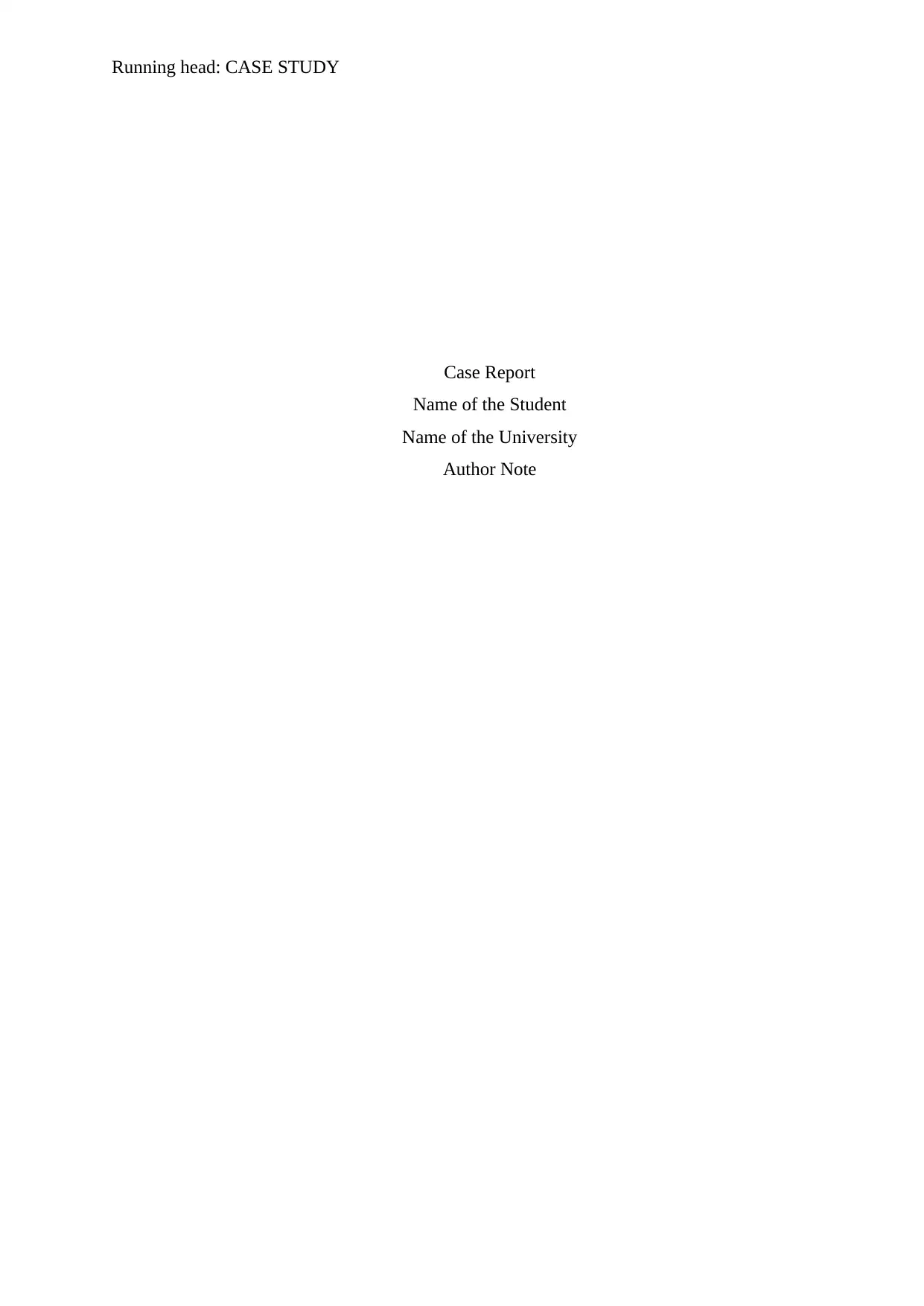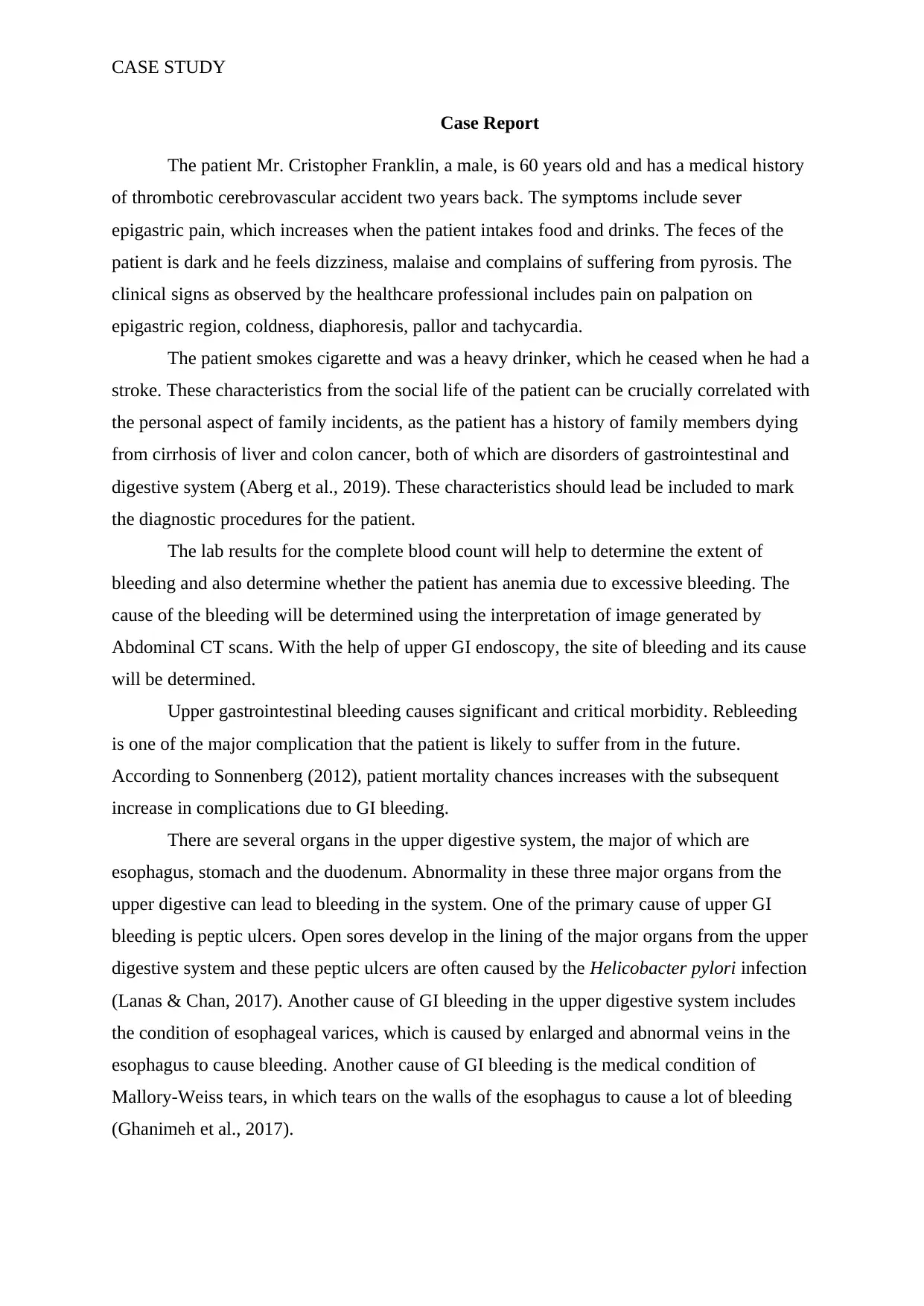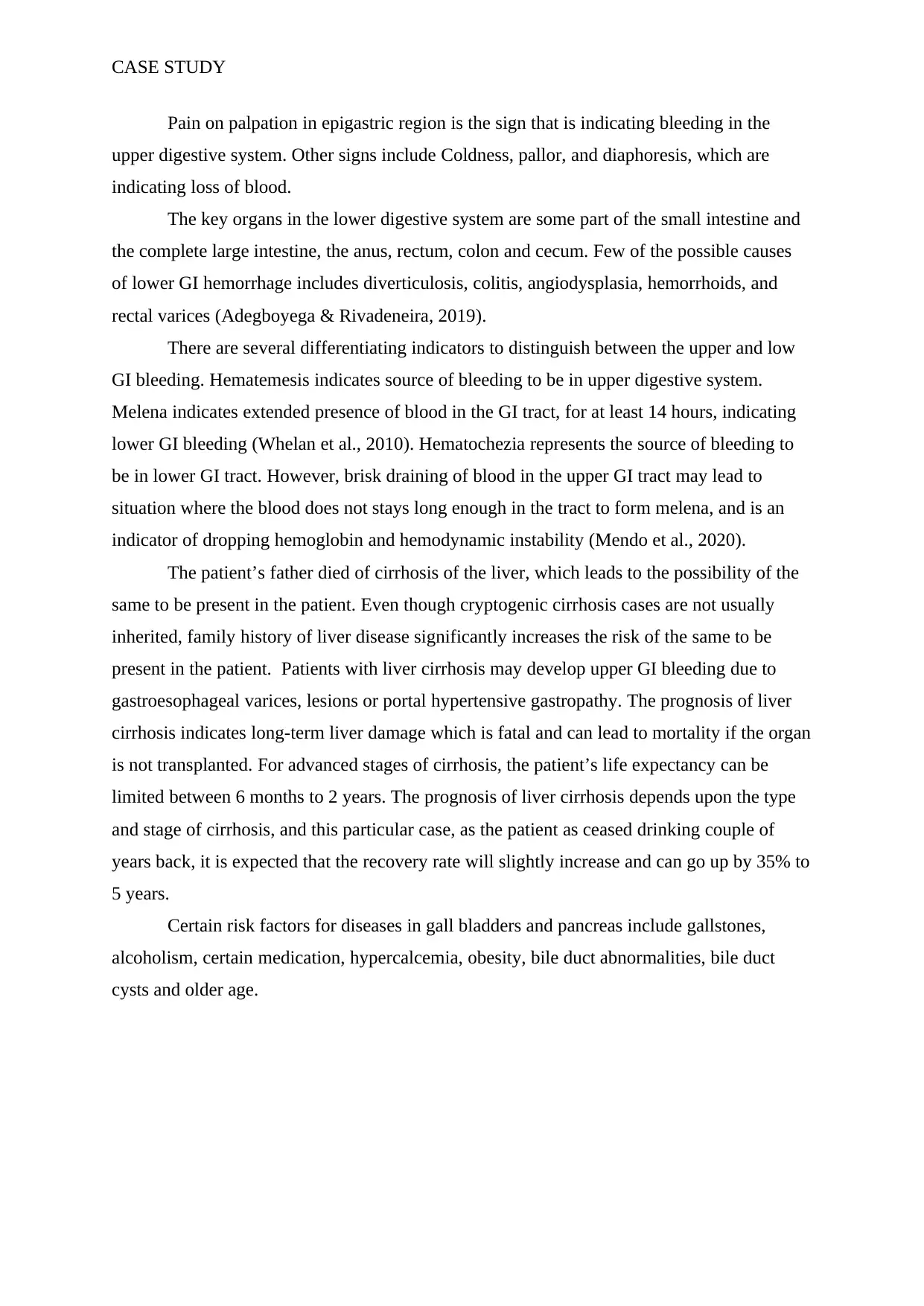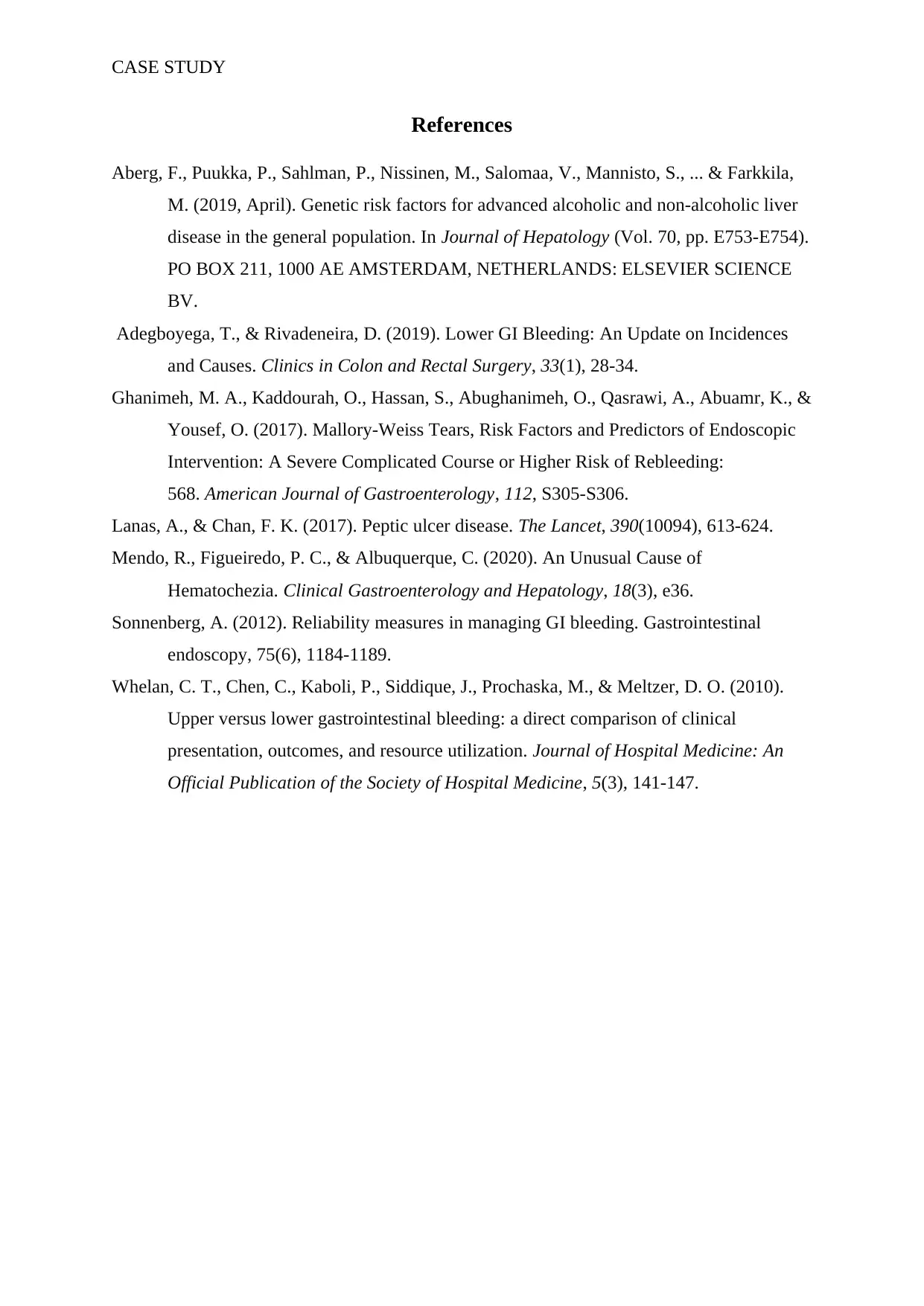Case Study: Clinical Analysis of Upper GI Bleeding and Patient History
VerifiedAdded on 2022/08/16
|4
|1234
|19
Case Study
AI Summary
This case study presents a 60-year-old male patient with a history of a cerebrovascular accident and experiencing symptoms of severe epigastric pain, dark feces, dizziness, malaise, and pyrosis. The patient's medical history includes smoking and heavy alcohol consumption, along with a family history of liver and colon disorders. The case study details the clinical signs, including pain on palpation, coldness, diaphoresis, pallor, and tachycardia, along with the diagnostic procedures like complete blood count, abdominal CT scans, and upper GI endoscopy. The document discusses potential causes of upper GI bleeding, such as peptic ulcers, esophageal varices, and Mallory-Weiss tears, differentiating between upper and lower GI bleeding indicators. It also considers the patient's risk for liver cirrhosis and its prognosis, referencing relevant medical literature and highlighting the importance of family history in diagnosis.

Running head: CASE STUDY
Case Report
Name of the Student
Name of the University
Author Note
Case Report
Name of the Student
Name of the University
Author Note
Paraphrase This Document
Need a fresh take? Get an instant paraphrase of this document with our AI Paraphraser

CASE STUDY
Case Report
The patient Mr. Cristopher Franklin, a male, is 60 years old and has a medical history
of thrombotic cerebrovascular accident two years back. The symptoms include sever
epigastric pain, which increases when the patient intakes food and drinks. The feces of the
patient is dark and he feels dizziness, malaise and complains of suffering from pyrosis. The
clinical signs as observed by the healthcare professional includes pain on palpation on
epigastric region, coldness, diaphoresis, pallor and tachycardia.
The patient smokes cigarette and was a heavy drinker, which he ceased when he had a
stroke. These characteristics from the social life of the patient can be crucially correlated with
the personal aspect of family incidents, as the patient has a history of family members dying
from cirrhosis of liver and colon cancer, both of which are disorders of gastrointestinal and
digestive system (Aberg et al., 2019). These characteristics should lead be included to mark
the diagnostic procedures for the patient.
The lab results for the complete blood count will help to determine the extent of
bleeding and also determine whether the patient has anemia due to excessive bleeding. The
cause of the bleeding will be determined using the interpretation of image generated by
Abdominal CT scans. With the help of upper GI endoscopy, the site of bleeding and its cause
will be determined.
Upper gastrointestinal bleeding causes significant and critical morbidity. Rebleeding
is one of the major complication that the patient is likely to suffer from in the future.
According to Sonnenberg (2012), patient mortality chances increases with the subsequent
increase in complications due to GI bleeding.
There are several organs in the upper digestive system, the major of which are
esophagus, stomach and the duodenum. Abnormality in these three major organs from the
upper digestive can lead to bleeding in the system. One of the primary cause of upper GI
bleeding is peptic ulcers. Open sores develop in the lining of the major organs from the upper
digestive system and these peptic ulcers are often caused by the Helicobacter pylori infection
(Lanas & Chan, 2017). Another cause of GI bleeding in the upper digestive system includes
the condition of esophageal varices, which is caused by enlarged and abnormal veins in the
esophagus to cause bleeding. Another cause of GI bleeding is the medical condition of
Mallory-Weiss tears, in which tears on the walls of the esophagus to cause a lot of bleeding
(Ghanimeh et al., 2017).
Case Report
The patient Mr. Cristopher Franklin, a male, is 60 years old and has a medical history
of thrombotic cerebrovascular accident two years back. The symptoms include sever
epigastric pain, which increases when the patient intakes food and drinks. The feces of the
patient is dark and he feels dizziness, malaise and complains of suffering from pyrosis. The
clinical signs as observed by the healthcare professional includes pain on palpation on
epigastric region, coldness, diaphoresis, pallor and tachycardia.
The patient smokes cigarette and was a heavy drinker, which he ceased when he had a
stroke. These characteristics from the social life of the patient can be crucially correlated with
the personal aspect of family incidents, as the patient has a history of family members dying
from cirrhosis of liver and colon cancer, both of which are disorders of gastrointestinal and
digestive system (Aberg et al., 2019). These characteristics should lead be included to mark
the diagnostic procedures for the patient.
The lab results for the complete blood count will help to determine the extent of
bleeding and also determine whether the patient has anemia due to excessive bleeding. The
cause of the bleeding will be determined using the interpretation of image generated by
Abdominal CT scans. With the help of upper GI endoscopy, the site of bleeding and its cause
will be determined.
Upper gastrointestinal bleeding causes significant and critical morbidity. Rebleeding
is one of the major complication that the patient is likely to suffer from in the future.
According to Sonnenberg (2012), patient mortality chances increases with the subsequent
increase in complications due to GI bleeding.
There are several organs in the upper digestive system, the major of which are
esophagus, stomach and the duodenum. Abnormality in these three major organs from the
upper digestive can lead to bleeding in the system. One of the primary cause of upper GI
bleeding is peptic ulcers. Open sores develop in the lining of the major organs from the upper
digestive system and these peptic ulcers are often caused by the Helicobacter pylori infection
(Lanas & Chan, 2017). Another cause of GI bleeding in the upper digestive system includes
the condition of esophageal varices, which is caused by enlarged and abnormal veins in the
esophagus to cause bleeding. Another cause of GI bleeding is the medical condition of
Mallory-Weiss tears, in which tears on the walls of the esophagus to cause a lot of bleeding
(Ghanimeh et al., 2017).

CASE STUDY
Pain on palpation in epigastric region is the sign that is indicating bleeding in the
upper digestive system. Other signs include Coldness, pallor, and diaphoresis, which are
indicating loss of blood.
The key organs in the lower digestive system are some part of the small intestine and
the complete large intestine, the anus, rectum, colon and cecum. Few of the possible causes
of lower GI hemorrhage includes diverticulosis, colitis, angiodysplasia, hemorrhoids, and
rectal varices (Adegboyega & Rivadeneira, 2019).
There are several differentiating indicators to distinguish between the upper and low
GI bleeding. Hematemesis indicates source of bleeding to be in upper digestive system.
Melena indicates extended presence of blood in the GI tract, for at least 14 hours, indicating
lower GI bleeding (Whelan et al., 2010). Hematochezia represents the source of bleeding to
be in lower GI tract. However, brisk draining of blood in the upper GI tract may lead to
situation where the blood does not stays long enough in the tract to form melena, and is an
indicator of dropping hemoglobin and hemodynamic instability (Mendo et al., 2020).
The patient’s father died of cirrhosis of the liver, which leads to the possibility of the
same to be present in the patient. Even though cryptogenic cirrhosis cases are not usually
inherited, family history of liver disease significantly increases the risk of the same to be
present in the patient. Patients with liver cirrhosis may develop upper GI bleeding due to
gastroesophageal varices, lesions or portal hypertensive gastropathy. The prognosis of liver
cirrhosis indicates long-term liver damage which is fatal and can lead to mortality if the organ
is not transplanted. For advanced stages of cirrhosis, the patient’s life expectancy can be
limited between 6 months to 2 years. The prognosis of liver cirrhosis depends upon the type
and stage of cirrhosis, and this particular case, as the patient as ceased drinking couple of
years back, it is expected that the recovery rate will slightly increase and can go up by 35% to
5 years.
Certain risk factors for diseases in gall bladders and pancreas include gallstones,
alcoholism, certain medication, hypercalcemia, obesity, bile duct abnormalities, bile duct
cysts and older age.
Pain on palpation in epigastric region is the sign that is indicating bleeding in the
upper digestive system. Other signs include Coldness, pallor, and diaphoresis, which are
indicating loss of blood.
The key organs in the lower digestive system are some part of the small intestine and
the complete large intestine, the anus, rectum, colon and cecum. Few of the possible causes
of lower GI hemorrhage includes diverticulosis, colitis, angiodysplasia, hemorrhoids, and
rectal varices (Adegboyega & Rivadeneira, 2019).
There are several differentiating indicators to distinguish between the upper and low
GI bleeding. Hematemesis indicates source of bleeding to be in upper digestive system.
Melena indicates extended presence of blood in the GI tract, for at least 14 hours, indicating
lower GI bleeding (Whelan et al., 2010). Hematochezia represents the source of bleeding to
be in lower GI tract. However, brisk draining of blood in the upper GI tract may lead to
situation where the blood does not stays long enough in the tract to form melena, and is an
indicator of dropping hemoglobin and hemodynamic instability (Mendo et al., 2020).
The patient’s father died of cirrhosis of the liver, which leads to the possibility of the
same to be present in the patient. Even though cryptogenic cirrhosis cases are not usually
inherited, family history of liver disease significantly increases the risk of the same to be
present in the patient. Patients with liver cirrhosis may develop upper GI bleeding due to
gastroesophageal varices, lesions or portal hypertensive gastropathy. The prognosis of liver
cirrhosis indicates long-term liver damage which is fatal and can lead to mortality if the organ
is not transplanted. For advanced stages of cirrhosis, the patient’s life expectancy can be
limited between 6 months to 2 years. The prognosis of liver cirrhosis depends upon the type
and stage of cirrhosis, and this particular case, as the patient as ceased drinking couple of
years back, it is expected that the recovery rate will slightly increase and can go up by 35% to
5 years.
Certain risk factors for diseases in gall bladders and pancreas include gallstones,
alcoholism, certain medication, hypercalcemia, obesity, bile duct abnormalities, bile duct
cysts and older age.
⊘ This is a preview!⊘
Do you want full access?
Subscribe today to unlock all pages.

Trusted by 1+ million students worldwide

CASE STUDY
References
Aberg, F., Puukka, P., Sahlman, P., Nissinen, M., Salomaa, V., Mannisto, S., ... & Farkkila,
M. (2019, April). Genetic risk factors for advanced alcoholic and non-alcoholic liver
disease in the general population. In Journal of Hepatology (Vol. 70, pp. E753-E754).
PO BOX 211, 1000 AE AMSTERDAM, NETHERLANDS: ELSEVIER SCIENCE
BV.
Adegboyega, T., & Rivadeneira, D. (2019). Lower GI Bleeding: An Update on Incidences
and Causes. Clinics in Colon and Rectal Surgery, 33(1), 28-34.
Ghanimeh, M. A., Kaddourah, O., Hassan, S., Abughanimeh, O., Qasrawi, A., Abuamr, K., &
Yousef, O. (2017). Mallory-Weiss Tears, Risk Factors and Predictors of Endoscopic
Intervention: A Severe Complicated Course or Higher Risk of Rebleeding:
568. American Journal of Gastroenterology, 112, S305-S306.
Lanas, A., & Chan, F. K. (2017). Peptic ulcer disease. The Lancet, 390(10094), 613-624.
Mendo, R., Figueiredo, P. C., & Albuquerque, C. (2020). An Unusual Cause of
Hematochezia. Clinical Gastroenterology and Hepatology, 18(3), e36.
Sonnenberg, A. (2012). Reliability measures in managing GI bleeding. Gastrointestinal
endoscopy, 75(6), 1184-1189.
Whelan, C. T., Chen, C., Kaboli, P., Siddique, J., Prochaska, M., & Meltzer, D. O. (2010).
Upper versus lower gastrointestinal bleeding: a direct comparison of clinical
presentation, outcomes, and resource utilization. Journal of Hospital Medicine: An
Official Publication of the Society of Hospital Medicine, 5(3), 141-147.
References
Aberg, F., Puukka, P., Sahlman, P., Nissinen, M., Salomaa, V., Mannisto, S., ... & Farkkila,
M. (2019, April). Genetic risk factors for advanced alcoholic and non-alcoholic liver
disease in the general population. In Journal of Hepatology (Vol. 70, pp. E753-E754).
PO BOX 211, 1000 AE AMSTERDAM, NETHERLANDS: ELSEVIER SCIENCE
BV.
Adegboyega, T., & Rivadeneira, D. (2019). Lower GI Bleeding: An Update on Incidences
and Causes. Clinics in Colon and Rectal Surgery, 33(1), 28-34.
Ghanimeh, M. A., Kaddourah, O., Hassan, S., Abughanimeh, O., Qasrawi, A., Abuamr, K., &
Yousef, O. (2017). Mallory-Weiss Tears, Risk Factors and Predictors of Endoscopic
Intervention: A Severe Complicated Course or Higher Risk of Rebleeding:
568. American Journal of Gastroenterology, 112, S305-S306.
Lanas, A., & Chan, F. K. (2017). Peptic ulcer disease. The Lancet, 390(10094), 613-624.
Mendo, R., Figueiredo, P. C., & Albuquerque, C. (2020). An Unusual Cause of
Hematochezia. Clinical Gastroenterology and Hepatology, 18(3), e36.
Sonnenberg, A. (2012). Reliability measures in managing GI bleeding. Gastrointestinal
endoscopy, 75(6), 1184-1189.
Whelan, C. T., Chen, C., Kaboli, P., Siddique, J., Prochaska, M., & Meltzer, D. O. (2010).
Upper versus lower gastrointestinal bleeding: a direct comparison of clinical
presentation, outcomes, and resource utilization. Journal of Hospital Medicine: An
Official Publication of the Society of Hospital Medicine, 5(3), 141-147.
1 out of 4
Related Documents
Your All-in-One AI-Powered Toolkit for Academic Success.
+13062052269
info@desklib.com
Available 24*7 on WhatsApp / Email
![[object Object]](/_next/static/media/star-bottom.7253800d.svg)
Unlock your academic potential
Copyright © 2020–2025 A2Z Services. All Rights Reserved. Developed and managed by ZUCOL.



